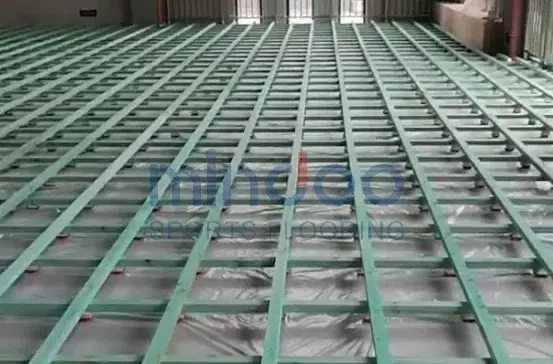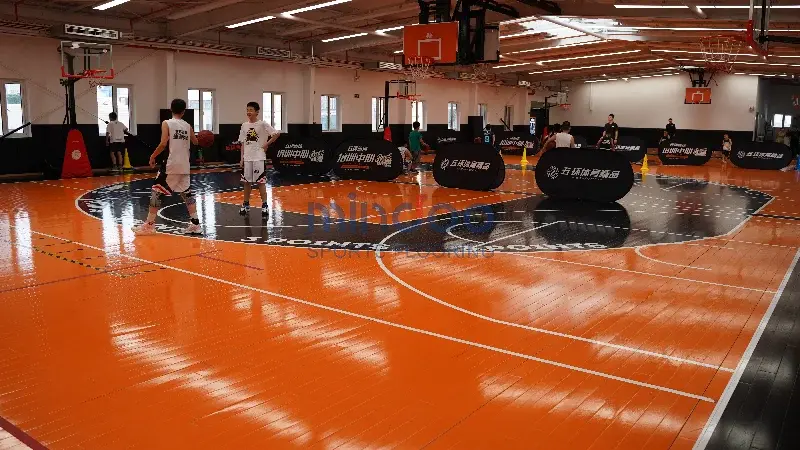How do you choose the right thickness for a wood floor panel?
Choosing the right thickness for your wood basketball floor is a very important choice that will affect how well your flooring works, how long it lasts, and how it looks. If you're a contractor, facility operator, or property developer, you need to know what elements affect this option. This complete guide will help you choose the proper thickness for your wood floor panel by going over all the important things to think about.
Things that affect the choice of thickness for wood floor panels
When deciding how thick your wood floor panel should be, there are a number of important things to think about:
Use and amount of traffic
The main use of the room and how many people walk through it are important factors in deciding how thick the flooring panels should be. Thicker panels are better for places that have a lot of foot traffic, such gyms, stores, and busy halls, since they can handle regular usage and possible collisions. Thicker panels are better at withstanding wear and tear, which helps them keep their look and function over time. This makes them great for places that have a lot of foot traffic every day.
Condition of the Subfloor

Another thing to think about when picking the thickness of your panels is how the subfloor is doing. If the subfloor is not level or is broken, it might cause problems that could make the flooring less stable. Thicker panels may assist make up for these flaws, making sure that the floor has a smooth and solid surface to be built on. A thicker panel will provide you greater support and assist prevent any problems that could come up because of an uneven flooring from happening.
How to Install
Varied ways of installing panels typically need panels of varied thicknesses. For instance, floating floors, which don't need nails or glue, usually employ thinner panels than standard nail-down flooring. The floating floor approach lets the panels move around freely, therefore thinner panels are a better option. On the other hand, nail-down installations are more stable and may benefit from thicker panels that fit better and last longer.
Requirements for Sound
Thicker panels may provide better soundproofing in places where sound insulation is crucial, such offices, theaters, or multi-story structures. Thicker flooring panels assist block sound from moving between levels, making the area more soundproof. This is especially helpful in places where keeping noise pollution to a minimum is important, since it makes the space quieter and more pleasant for those who live there.
How panel thickness affects stability and load capacity

The thickness of the wood basketball floor plays a vital role in determining its stability and ability to bear weight:
Continuity of the Structure
In most cases, panels that are thicker provide superior structural stability, which makes them less likely to warp or cup over the course of many years. Especially in regions where the humidity levels are constantly changing, this is of utmost importance.
Supporting Capacity for Loads
The load-bearing capability of a material normally increases in proportion to its additional thickness. For places that may store heavy equipment or furniture, as well as locations that are exposed to significant impact, such as sports courts, this is an extremely important consideration.
Insulation from the heat
Your area may benefit from increased energy efficiency if you install panels that are thicker since they might offer superior thermal insulation. It is possible that this will be particularly useful in areas that experience significant temperature differentials.
Relationship between thickness, subfloor, and usage type
The interplay between panel thickness, subfloor characteristics, and intended use is crucial for optimal flooring performance.
Compatibility with the Subfloor
Depending on the kind of subfloor material, the panel thickness may need to be adjusted in order to ensure good installation. As an example, concrete subfloors could need panels that are more substantial in order to accommodate the possibility of moisture problems.
Specific Requirements, Based on Usage
Specific thickness limits are sometimes imposed for specialized usage, such as wood basketball floors, in order to fulfill performance criteria for the bounce of the ball and the safety of the players.
Long-Term Capability to Last
One way to decide the thickness that is most suitable for the area is to take into account how it will be used over the long run. Investing in panels that are thicker and more robust may be beneficial for areas that are anticipated to see high usage for decades.
Testing methods to validate thickness selection
If you want to be sure the panel thickness you choose will work, there are a few ways to test it:
Resistance Testing for Impacts
Flooring panels must be tested for impact resistance to determine its ability to endure abrupt and powerful impacts. This is especially important for commercial areas with heavy foot traffic and sports surfaces. The flooring in places like gyms, basketball courts, or crowded retail spaces often takes a beating from heavy machinery or people's feet. This test mimics actual use to make sure the flooring can withstand heavy foot traffic without bending or cracking, which is important for both performance and appearance.
Evaluation of Deflection
Deflection testing determines the maximum allowable deformation of a flooring panel under load. The panels must pass this test to guarantee they are strong enough to withstand a range of pressures and weights without deforming or breaking. The flooring has to be comfortable, long-lasting, and resistant to bending under severe loads for various applications including homes, businesses, and sports arenas. The results of these tests are very useful in deciding what thickness and material to use for various applications.
Assessment of Resistance to Moisture
Due to their increased susceptibility to variations in humidity and moisture levels, thinner flooring panels need a more thorough assessment of their moisture resistance. To make sure the flooring won't bend, bulge, or otherwise lose its structural integrity when exposed to water, this test is performed. It's an absolute must in places with unpredictable humidity, such as basements, restrooms, or fitness centers. When considering flooring options for damp areas, it is important to look for a panel that can withstand a lot of water without deteriorating over time. This will help keep problems like mildew and surface damage at bay.
Striking a balance between installation convenience, performance, and cost
Finding the optimal equilibrium between the following factors is the key to opting for a decision that is economical:
A Comparison of Costs Over the Short-Term and the Long-Term
As a result of their greater longevity and reduced need for maintenance, thick panels often end up being more cost-effective in the long term, despite the fact that they may initially be more costly.
Assessing the Effectiveness of Criteria
Avoid over- or under-engineering the solution by taking into consideration the specific performance requirements of the region in which your flooring will be placed.
Important Considerations for the Installation Process
Consider the ease with which the panels may be installed as well as the fee that will be required to do so. It is possible that thicker panels may need specialist equipment or procedures, which might result in an increase in the total cost of the project.
Conclusion
A number of elements must be carefully considered when deciding on the appropriate thickness of wood basketball floor. Make a well-informed decision that strikes a balance between performance, durability, and cost-effectiveness by learning about the link between thickness, subfloor conditions, and planned usage. If you want your flooring solution to last for years, it's important to think about its long-term worth and your individual use requirements.
FAQ
1. How thick are wood floor panels typically?
There is no universally accepted measurement for solid wood sports flooring thickness; nevertheless, the most frequent range is 18–22 millimeters. Subfloor condition, planned usage, and project requirements are some of the variables that determine the optimal thickness.
2. How about soundproofing? Would thicker wood floor panels work?
The answer is yes, in most cases, thicker wood floor panels will provide superior soundproofing. Because of the extra bulk, sound waves are absorbed and dampened, which in turn reduces the transmission of noise between floors.
3. Installation time and cost are impacted by panel thickness in what ways?
Installation time and labor expenses might go up, and specialist handling could be necessary for thicker panels. On the other hand, their superior long-term endurance may more than make up for the higher upfront expenses by cutting down on replacement and maintenance requirements.
Get the Best Wood Floor Panels at Mindoo!
Leave it to Mindoo to provide you with top-notch advice and assistance in choosing the wood floor panels that are ideal for your project. From 18 mm all the way up to 22 mm and beyond, we have a wide choice of thicknesses to choose from as a top wood basketball floor manufacturer. Our ability to tailor our services to your unique requirements, reasonable prices, and stringent quality control measures are all benefits of our wholly-owned facility. Mindoo is a trustworthy partner for high-performance wood flooring solutions, with a wealth of expertise in a wide range of building projects and certifications from across the world. To learn more about the Mindoo difference and to discuss your needs for wood floor panels, contact us immediately at sales@mindoofloor.com.
References
1. Johnson, L. (2022). "The Impact of Wood Floor Panel Thickness on Performance and Durability." Journal of Sports Facility Engineering, 15(3), 78-92.
2. Smith, A. & Brown, T. (2021). "Optimizing Wood Floor Panel Selection for Commercial Spaces." Building Materials Review, 29(2), 112-125.
3. International Wood Flooring Association. (2023). "Guidelines for Selecting Appropriate Wood Floor Panel Thickness." IWFA Technical Bulletin, 7(1), 1-18.
4. Chen, H. et al. (2020). "Acoustic Properties of Varying Thickness Wood Floor Panels." Applied Acoustics, 161, 107-118.
5. National Basketball Association. (2022). "Official Court Flooring Specifications." NBA Facility Standards, 2022 Edition, 45-52.
6. European Committee for Standardization. (2021). "Wood Flooring - Determination of Elasticity and Resistance to Wear." EN 14904:2021.